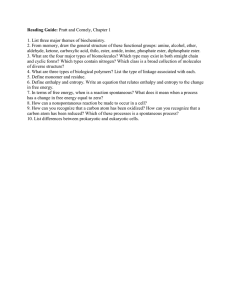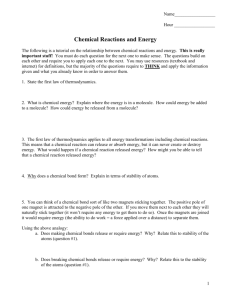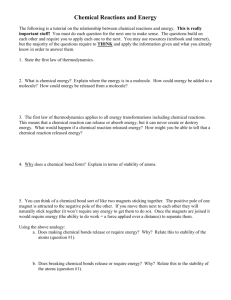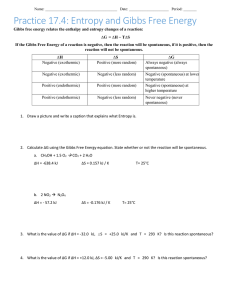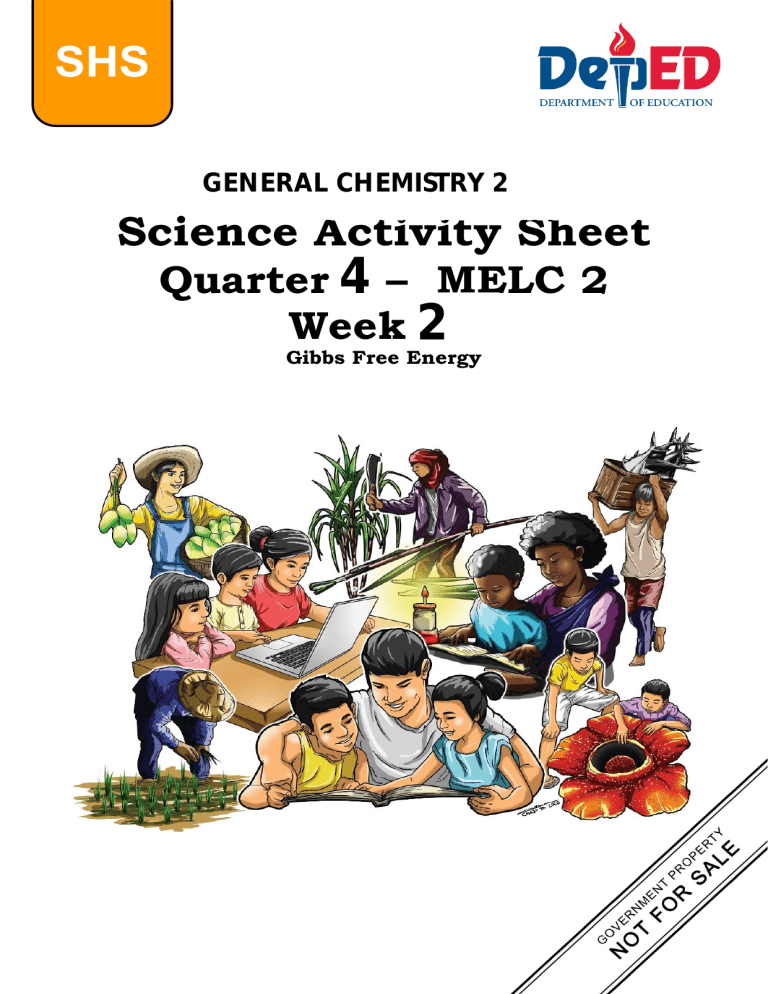
SHS GENERAL CHEMISTRY 2 Science Activity Sheet Quarter 4 2 – MELC 2 Week 2 1B Gibbs Free Energy General Chemistry 2 Activity Sheet No. 2 Gibbs Free Energy First Edition, 2020 Published in the Philippines By the Department of Education Region 6 – Western Visayas Republic Act 8293, section 176 states that: No copyright shall subsist in any work of the Government of the Philippines. However, prior approval of the government agency or office wherein the work is created shall be necessary for exploitation of such work for profit. Such agency or office may, among other things, impose as a condition the payment of royalties. This Learning Activity Sheet is developed by DepEd Schools Division of Iloilo. ALL RIGHTS RESERVED. No part of this learning resource may be reproduced or transmitted in any form or by any means electronic or mechanical without written permission from the DepEd Schools Division of Iloilo. Development Team of Activity Sheet Writers: Ruth Grace Comodero Illustrators: Ruth Grace Comodero Editor: Zaldy M. Tondo Layout Artist: Zaldy M. Tondo Division Management Team: Zaldy M. Tondo Corazon C. Alarcon Regional Management Team: Roel F. Bermejo Nordy D. Siason Jr., EdD. Lilibeth T. Estoque, EdD. Azucena T. Falales, PhD. Introductory Message Welcome! The Learning Activity Sheet is a product of the Schools Division of Iloilo through the Curriculum Implementation Division (CID). This is developed to guide the learning facilitators (teachers, parents and responsible adults) in helping the learners meet the standards set by the K to 12 Basic Education Curriculum. The Learning Activity Sheet is a self-directed instructional material aimed to guide the learners in accomplishing activities at their own pace and time using the contextualized resources in the community. This will also assist the learners in acquiring the lifelong learning skills, knowledge and attitudes for productivity and employment. For learning facilitator: The Learning Activity Sheet will help you facilitate the leaching-learning activities specified in each Most Essential Learning Competency (MELC) with minimal or no face-to-face encounter between you and learner. This will be made available to the learners with the references/links to ease the independent learning. For the learner: The Learning Activity Sheet is developed to help you continue learning even if you are not in school. This learning material provides you with meaningful and engaging activities for independent learning. Being an active learner, carefully read and understand the instructions then perform the activities and answer the assessments. This will be returned to your facilitator on the agreed schedule. Name of Learner: _____________________________________________________ Grade& Section______________________________Date: ___________________ GENERAL CHEMISTRY 2 ACTIVITY SHEET NO. 2 Gibbs Free Energy I. Learning Competency with Code Use Gibbs’ free energy to determine the direction of a reaction (STEM_GC11CT-IVa-b-143) II. Background Information for Learners The thermodynamic entity that takes into account both enthalpy and entropy changes and is useful for determining whether a process is spontaneous or not is called Gibbs free energy. The Gibbs free energy change (∆G) for reaction carried out at constant temperature in Kelvin and pressure is given by ∆G = ∆H -T∆S where both ∆H and ∆S refer to the system. The Gibbs free energy change is equal to the maximum possible work (w) that can be obtained from a process. Any process that occurs spontaneously can be utilized to perform useful work. The Gibbs free energy of the system will decrease (∆G<0) in a spontaneous process, and will increase (∆G >0) in a nonspontaneous process. For example, the movement of water in waterfall is spontaneous. Useful work, for example, in turning the wheels of a turbine, can be derived from the process. On the other hand, a positive ∆G indicates that work has to be done on the system for the process to take place. Such process is nonspontaneous. The maintenance of life is nonspontaneous process; it requires the sustained input of work or energy as maybe obtained from food. The free energy criteria (at constant temperature and pressure) are summarized as follows: If ∆G < 0, the forward reaction is spontaneous. If ∆G = 0, the reaction is at equilibrium. If ∆G < 0, the forward reaction is nonspontaneous. The reverse reaction will have a negative ∆G and will be spontaneous. The standard free-energy change of reaction (∆Gºrxn) is the free –energy change for a reaction when it occurs under standard state conditions, when reactants in their standard states are converted to products in their standard states. Calculation of ∆Gºrxn. The free energy change for a reaction can be calculated in two ways. When both ∆H and ∆S are known, then ∆G = ∆H -T∆S will give the free energy change at the temperature T. ∆Gºrxn can also be calculated from standard free energies of formation in a manner analogous to the calculation of ∆Hº by using enthalpies of formation of the reactants and products. The standard free energies of formation (∆Gºf) of selected compounds are tabulated below (Table 2.1). Just as for the 1 standard enthalpies of formation, the free energies of formation of elements in their standard states are equal to zero. For a general reaction aA + bB cC + dD The standard free energy change is given by ∆Gºrxn = [c∆Gºf (C) + d∆Gºf (D)] - [a∆Gºf (A) + b∆Gºf (B)] In general: ∆Gºrxn = ∑n∆Gºf(products) - ∑m∆Gºf(reactants) Where n and m are stoichiometric coeficients. Table 2.1 Standard Gibbs free energy of formation of selected substances. https://www.google.com/url?sa=i&url=http%3A%2F%2Fwiki.chemprime.cheme ddl.org%2Farticles%2Fs%2Ft%2Fa%2FFile~Standard_Free_Energies_of_Formati on.jpg_c314.html&psig=AOvVaw06AWRbEU4gWDgDtqBzRyc2&ust=161167685 1721000&source=images&cd=v Sample Problem 1: Calculate ∆Gºrxn at 25ºC for the following reaction given that: ∆Gºf (Fe2O3) = -741.0 kJ/mol ∆Gºf (Al2O3) = -1576.4 kJ/mol 2 2Al(s) + Fe2O3(s) Method of Solution Al2O3(s) + 2Fe(s) ∆Gºrxn = [∆Gºf (Al2O3) + 2∆Gºf (Fe)] - [2∆Gºf (Al) + ∆Gºf (Fe2O3)] = [ 1mol (-1576.41 kJ/mol) + 0 ]-[ 0+ 1mol (741.0 kJ/mol)) ∆Gºrxn = -1576.41 kJ + 741.0 kJ = - 835.4 kJ Temperature and the Free Energy Change From the equation ∆G = ∆H - T∆S we can see that temperature too will influence the spontaneity of reaction. If both ∆H and ∆S are positive then at low temperature, as long as ∆H > T∆S, ∆G is positive and the process will be nonspontaneous. However, as temperature increases, the T∆S term increases and eventually ∆H = T∆S. At this point ∆G is zero. With further T increase, T∆S > ∆H, making ∆G < 0, and the reaction becomes spontaneous. Table 2.1 summarizes the four possible situtions affecting the ∆G of a reaction. Table 2.2. Enthalpy and Entropy Factors that the signs of ∆Gºrxn ∆H + ∆S + ∆G ∆G is positive at low temperatures and negative at high temperature Characteristic of Reaction Nonspontaneous at lower temperature Spontaneous at higher temperature + _ ∆G is positive at all tempratures Nonspontaneous at any temperature - + ∆G is negative temperatures - - ∆G is negative at low Nonspontaneous at higher temperatures and positive at temperature high temperature Spontaneous at lower temperature at all Spontaneous at all temperature Brown, Le May and Bursten. Chemistry: The Central Science, 9th ed. 2004 Sample Problem 2: The old camera flash bulb used Mg metal sealed in a bulb with oxygen. The reaction is: S° J/K mol: ΔH°f kJ/mol: Mg 32.7 0 + ½ O2 —> 205.0 0 3 MgO 26.9 -601.2 Calculating the ΔS° ΔS° = ΣnS° (products) − ΣmS° (reactants) = [(1) S° MgO] – [(1) S° Mg + (½) S° O2] = [(1) (26.9)] – [(1)(32.7) + (½) (205.0)] ΔS° = -108.3 J/K mol Calculating the ΔH° ΔH° = Σ nΔHf° (products) – Σ mΔHf° (reactants) = [(1) ΔHf ° MgO] – [(1) ΔHf°Mg + (½) ΔHf°O2] = [(1) (-601.2)] – [(1) (0) + (½) (0)] ΔH° = -601.2k Calculating the ΔG ΔG = ΔH - TΔS = 601.2kJ - (298K) (-108.3J/K) (1kJ/1000J) = -601.2 + 32.3kJ ΔG = -568.9kJ Since ΔG is negative the reaction will form MgO amd it is spontaneous. III. Activity Proper Activity 1. Gibbs Free Energy For the reaction to be spontaneous, the sign of ∆G (Gibbs free energy) must be negative. The mathematical formula for this value is: ∆G = ∆H -T∆S Where: ∆H – change in enthalpy T- temperature in Kelvin ∆S – change in entropy Complete the table for the sign of ∆G: -, + or undetermined. When conditions allow for an undetermined sign of ∆G, temperature will decide spontaneously. 4 ∆H + ∆S - + + - + _ _ ∆G Answer the following below: 1. The conditions in which ∆G is always negative is when ∆H is ____________ and ∆S is ____________. 2. The conditions in ∆G is always positive is when ∆H is ____________ and ∆S is __________. 3. Under what conditions will a reaction with a decreasing entropy be spontaneous or thermodynamically favorable? 4. Under what conditions will an endothermic reaction be spontaneous or thermodynamically favorable? 5. An exothermic reaction is nonspontaneous or thermodynamically unfavorable under what conditions of temperature and entropy change? 6. When the situation is indeterminate, a low temperature favors the (entropy /enthalpy) factor, and a high temperature favors the (entropy/ enthalpy) factor. 7. Use complete sentences to explain how changes in enthalpy, temperature, and entropy would create each type of reaction. a. A reaction that is always favorable b. A reaction that is always unfavorable c. A reaction that is sometime favorable Activity 2. Is It Favorable or Not? Much like enthalpy and entropy, Gibbs free energy is a state function because they describe quantitatively an equilibrium state of a thermodynamic system, irrespective of how the system arrived in that state. Additionally, like enthalpy and entropy, Gibbs free energy can be calculated independently using the equation below. ∆Grxn˚ = ∑Gf˚ products - ∑Gf˚ reactants 1. What is the standard free energy change, ∆G˚, in kJ, for the following reaction at 298K? Is the reaction spontaneous? C2H5OH(l) + 3O2(g) —> 2CO2(g) + 3H2O(g) Compound C2H5OH(l) O2(g) CO2(g) H2O(g) ∆Gf˚ kJ/mol - 175 0 -394 -229 5 2. Calculate the ∆Gº for the reaction of graphite and predict whether the reaction is spontaneous or not: 2C(graphite) + H2(g) —> C2H2(g) 3. Copper (I) sulfide reacts with sulfur to produce copper (II) sulfide at 25°C. The process is exothermic (ΔH˚ = -26.7 kJ/mol) with a decrease in disorder (ΔS˚ = -19.7 J/(mol•K)). Determine the thermodynamic favorablity of the reaction by calculating ΔG˚. Cu2S(s) + S(s) → 2 CuS(s) 4. Is the reaction spontaneous at 298K and 1atm? CO(NH2)2 aq + H2O(l) —> CO2 (g) + 2NH3 (g) ∆Hº = 119kJ ∆Sº = 354.8 J/K T = 25ºC = 298K IV. Reflection Complete the statements below. I understand _________________________________________________________________ ______________________________________________________________________________ ______________________________________________________________________________ I don’t understand ___________________________________________________________ ______________________________________________________________________________ ______________________________________________________________________________ I need more information about _______________________________________________ ______________________________________________________________________________ ______________________________________________________________________________ 6 V. Answer Key VI. References Barrameda, M.C.B., Jusayan, S.R., Macale, A.M, Sabularse, V.S. (2016). Teaching Guide for Senior High School in General Chemistry 2.Commision on Higher Education. pp. 413-440. Brown, Le May and Bursten. Chemistry: The Central Science, 9th ed. 2004 Chang, R. (2007) Chemistry, 9th Ed. McGraw-Hill, Inc., USA. Whitten, K.W., et al (2007) Chemistry, 8th Ed. Thomson-Brooks/Cole, USA. https://www.google.com/url?sa=i&url=http%3A%2F%2Fwiki.chemprime.cheme ddl.org%2Farticles%2Fs%2Ft%2Fa%2FFile~Standard_Free_Energies_of_Formati on.jpg_c314.html&psig=AOvVaw06AWRbEU4gWDgDtqBzRyc2&ust=161167685 1721000&source=images&cd=v 7 8
